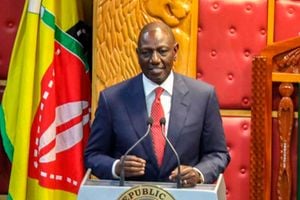
The shilling has recovered from a low of Sh160.75 against the US dollar to trade in a narrow range between Sh128 and Sh130 in recent months.
William Ruto inherited a litany of problems when he took over the helm of the country, from spiralling debt to a volatile foreign exchange market and soaring food and fuel prices.
The economic woes sparked fears that Kenya would default on its debt obligations amid a cash crunch that saw the government delay the payment of civil servants' salaries.
But fast forward to 2024 and green shots of economic recovery have emerged, at least at the macroeconomic level.
Among the positives are the cooling of inflation to a 17-year low of 2.7 percent in October and exchange rate stability, with the shilling trading at less than 130 units to the dollar from a high of Sh160.75 at the end of January.
This is despite the persistence of some challenges including high outstanding bills, cash-strapped households and businesses and expensive borrowing costs.
“I want to tell you that all is well in the future, we have a great country that is resilient, and we have always managed to come out of the worst,” Treasury Principal Secretary Chris Kiptoo told Kenyans at a public participation forum.
Inflation, for example, hit a five-year high of 8.3 percent in July as food and fuel costs remained stubbornly high.
The cost of living, as measured by inflation, has since eased with the change in consumer prices falling to a 17-year low of 2.7 percent in October.
The lowest cost of living measure since May 2007 was anchored by lower food and fuel inflation, which is the main component of inflation, alongside the CBK's increase in the policy rate to counter imported inflation from a weaker Kenya shilling.
“Food inflation which constitutes of nearly one third of the consumer prices basket has fallen to 5.1 percent on October 2024 from 15.8 percent in October 2023, that’s a whole 10 percent drop. This can be confirmed in the shelves, check what is the price of unga today and other components. Clearly, there has been some achievement on that end. Has the cost of living been addressed? To a large extent, I can say yes,” Dr Kiptoo added.
Measures taken by the Central Bank of Kenya (CBK) to reform monetary policy and the foreign exchange market, including the revival of the interbank foreign exchange market, the removal of a 20 cent cap between Forex ask and bid prices and the introduction of an electronic matching system for foreign exchange trades in the market, have helped to stabilise the shilling.
The availability of dollars to market participants has marked progress since last year's crisis, with the Kenya Shilling being one of the best performing currencies in the world this year.
The shilling has recovered from a low of Sh160.75 against the US dollar to trade in a narrow range between Sh128 and Sh130 in recent months.
Kenya's move to partially repurchase its debut Eurobond of Sh258.9 billion ($2 billion) in February this year helped to calm investor jitters, some of whom were expecting the government to default on its external debt obligations for the first time ever.
The end of investor gloom helped to boost foreign/dollar inflows into domestically issued government securities, providing the basis for the unit's performance so far this year.
The return of foreign inflows has further helped the CBK to boost its import buffer, known as official reserves, to Sh1.2 trillion ($9.276 billion) as at Thursday last week, equivalent to 4.8 months of import cover.
The reserves, which have been under pressure from the exchange rate, are now back above both the CBK's statutory requirement of four months of import cover and the East African Community (EAC) convergence criteria of 4.5 months.
Meanwhile, GDP growth has held steady in the face of economic pressures, with annualised growth expected to be higher at 5.6 percent in 2023 compared to 4.9 percent in 2022.
The steady growth has been underpinned mainly by improved rainfall, which has helped improve productivity in the agricultural sector, and the continued recovery of the services sector, which was previously held back by the impact of the pandemic.
Growth has remained largely unchanged so far in 2024, with GDP expanding by five and 4.6 percent in the first and second quarters, respectively.
However, macroeconomic challenges remain, including the unresolved stock of large outstanding bills, consumer purchasing power eroded by new statutory deductions, and high commercial bank interest rates.
The National Treasury has acknowledged the pressure from the debt bulge, which has limited the fiscal space to support other key expenditures such as development.
“The country still faces challenges such as high debt levels and the impact of climate change. Climate change poses significant risks to the country’s agriculture. With regards to debt vulnerabilities, our country still faces significant challenges which limit our fiscal space and constraints the broad-based development program,” said Dr Kiptoo.
President Ruto has set up various taskforces to address the remaining challenges, including the Pending Bills Verification Unit to clear legitimate arrears and a Public Debt Audit Unit to assess the portfolio of Kenya's outstanding debt.
Meanwhile, the government is banking on the CBK's interest rate cuts from August this year to not only reduce commercial bank lending rates but also the cost of borrowing from the domestic credit market for the Treasury.
The CBK and the National Treasury have been pressuring commercial banks to lower interest rates on loans to customers following two consecutive rate cuts in August and October, which brought the policy rate down to 12 percent from a multi-year high of 13 percent earlier this year.
Treasury bill yields have declined slightly since August, reflecting the impact of the CBK's lower policy rate.
Lower domestic interest rates are expected to stimulate credit demand in the economy, with private sector credit falling to a 22-year low of 0.4 percent in September, while non-performing loans are at an 18-year high of 16.7 percent in August.
Revenue shortfalls, however, continue to plague the exchequer as the weaker economy fails to generate the expected level of tax revenue.
The National Treasury has blamed the poor revenue performance in the first four months of the 2024/25 financial year on the withdrawal of the 2024 Finance Bill, which blew a Sh334 billion hole in this year's budget, and deadly street protests over new taxes in June and July that constrained economic activity.











